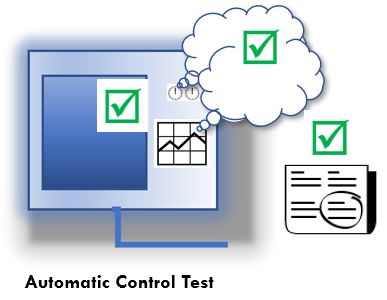0 Automatic Control Test
- Autoclave Validation
- by Kevin Peacock
- 30-07-2024

The automatic control test compares the performance of an operating cycle with its specification, normally by visual observation. The user activates an operating cycle and then observes each stage, noting the pressure and temperatures attained at each of the cycle switching points. The observed values are then compared with the specified values to ensure they remain within the defined tolerances for the cycle. Modern sterilizers carry out this test automatically using a control and monitoring system.
ISO 17665:2024 - Annex C.11
Introduction
In order to test the functionality of the operating cycle an automatic control test can be performed. The test checks the indicated and recorded cycle variables from instruments fitted to the sterilizer. Typically this test would be done as part of initial validation and then weekly as part of a periodic test routine. It is the main test for ensuring that the sterilizer continues to function correctly, as validated.
During commissioning and validation testing temperature and pressure sensors will be connected to the sterilizer for thermometric testing. If one sensor is located in the reference measurement point (usually the active chamber discharge or drain) then the calibration of the sterilizer instrumentation may be conveniently checked during the holding time of the automatic control test.
Test Procedure
For porous load sterilizers, place a standard test pack in the chamber, with the bottom of the pack supported 100-200 mm above the centre of the chamber base, (leave the chamber empty except for the usual chamber furniture).
For fluid sterilizers, for installation and commissioning tests, leave the chamber empty except for the usual chamber furniture. For periodic tests, load the chamber with a production load of a type for which a record has been established during performance qualification. If the test proves satisfactory, the sterilized load may be released for normal use.
Sterilizers designed for fluid loads equipped with one or two load sense probes to record the temperature of the load. If a production load is being processed, insert the probes into the load in the positions they would normally occupy. Otherwise stow the probes in accordance with the manufacturers recommendations.
Select the sterilization temperature for the operating cycle to be tested. As a rule, this should be the highest temperature compatible with the load. If a production load is being used, select the temperature at which it would normally be sterilized. Start the cycle.
Ensure that a process record is made by the recording instrument fitted to the sterilizer. Where a sterilizer does not have a process recorder, observe and note the elapsed time, indicated chamber temperatures and pressures at all significant points of the operating cycle, for example the beginning and end of each stage or sub-stage, and the maximum values during the holding time.
At the approximate mid-point of the plateau period, note the elapsed time and indicated chamber temperature and pressure.
For fluid loads, as soon as the cycle is complete, but before opening the door, observe and note the recorded temperature in the containers.
The test should be considered satisfactory if the following requirements are met: -
- a visual display of cycle complete is indicated;
- during the whole of the cycle the values of the cycle variables as shown on the batch process record are either within the limits established by the manufacturer as giving satisfactory results, or, for production loads, within the permitted tolerances marked on a master process record subsequently established during performance qualification;
- during the plateau period determined from the recorded chamber temperature:
- the indicated and recorded chamber temperatures are within the appropriate sterilization temperature band.
- the difference between the indicated and recorded chamber temperature does not exceed 2°C;
- the difference between the indicated and recorded chamber pressure does not exceed 0.1 bar;
- the holding time determined from any load temperature probes is not less than that specified in the appropriate sterilization temperature band.
- during the holding time, any temperatures recorded in the load are within the appropriate sterilization temperature band;
- the door cannot be opened until the cycle is complete;
- for fluid loads, at the end of the cycle the temperature recorded in the containers is not greater than 90°C (plastic) or 80°C (glass);
- the person conducting the test does not observe any mechanical or other anomaly.
Return to Schedule of Tests
